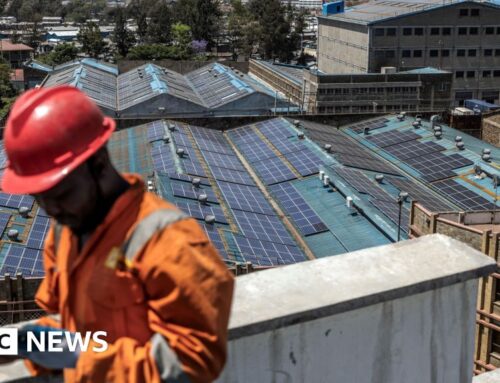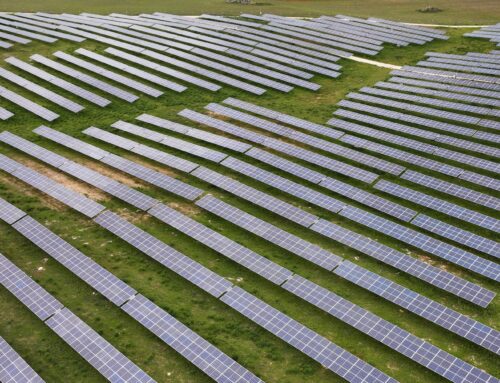US Renewable Energy Industry Analysis Report 2025-2033 Featuring GE, First Solar, Sunrun,
October 7, 2025
The United States Renewable Energy Market is projected to soar to 1,002.13 GW by 2033 from 429.55 GW in 2024, reflecting a CAGR of 3.64% from 2025 to 2033. This robust growth is fueled by technological advancements, investor interest, and supportive governmental policies. Key drivers include federal and state incentives like Renewable Portfolio Standards and tax credits, alongside falling costs and technological innovations in solar PV and wind turbines. The Edison & Sanborn Solar + Energy Storage project exemplifies this expansion. Despite challenges in grid infrastructure and regulatory complexity, the market is thriving across diverse states such as California, Texas, and New York, driven by a surge in demand from both businesses and consumers focused on sustainability.
U.S. Renewable Energy Market
Dublin, Oct. 07, 2025 (GLOBE NEWSWIRE) — The “United States Renewable Energy Market Report by Hydro Power, End User, States and Company Analysis, 2025-2033” report has been added to ResearchAndMarkets.com’s offering.
United States Renewable Energy Market is expected to reach US$ 1,002.13 Gigawatt by 2033 from US$ 429.55 Gigawatt in 2024, with a CAGR of 3.64% from 2025 to 2033.
With significant activity in the West, Midwest, and Northeast, the U.S. renewable energy sector is regionally diversified. Infrastructure, policy support, and resource availability all affect regional growth rates and technological choices.
With continuous growth anticipated across solar, wind, hydro, and developing green technologies, the U.S. renewable energy business is still expanding strongly because to investor interest, technology advancements, and governmental incentives. Over the past ten years, the US renewable energy sector has grown significantly and is now a significant part of the country’s energy mix. The sector, which is fueled by federal and state laws, uses a variety of energy sources, including as geothermal, hydroelectric, wind, solar, and biofuels. Businesses at every stage of the value chain, from utilities and financiers to equipment makers and project developers, are actively involved in the national expansion of sustainable energy solutions.
As governments, corporations, and consumers place a higher priority on decarbonization, investments in renewable energy have increased dramatically. Advances in battery storage and smart grid technology are complementing major infrastructure investments like offshore wind projects and utility-scale solar arrays. Renewables are now more competitive with fossil fuels because to the private sector’s dedication to clean energy procurement and supportive laws like tax credits and clean energy standards.
With costs continuing to drop and innovation accelerating, the future of the U.S. renewable energy sector is bright. Although there are differences in regional markets, the overall trend indicates that usage is rising across all industries. Integration issues still exist, particularly with regard to energy storage and grid modernization, but continuous research and development is overcoming these obstacles.
The industry’s contribution to energy independence, environmental sustainability, and job creation guarantees its ongoing strategic significance. All solar market categories saw this growth, which resulted in a total installed capacity of almost 188 GW across the country. With 22.5 GW of additional capacity, the utility-scale sector was instrumental, and almost 800,000 US residents installed solar systems in their homes.
Before ramping up to 60 GW yearly between 2025 and 2030, the United States intends to add an average of 30 GW of solar capacity annually until 2025. With cumulative solar installed capacity predicted to reach 673 GW by 2034 – enough to power over 100 million homes – this ambitious objective is anticipated to propel the market for solar photovoltaics (PV) to grow quickly.
The Edwards & Sanborn Solar + Energy Storage project, which was introduced by Terra-Gen and Mortenson in January 2024, is a noteworthy undertaking that highlights this expansion. 1.9 million First Solar panels, with a solar capacity of 875 megawatts direct current (MWdc) and roughly 3.3 gigawatt-hours (GWh) of energy storage, are part of this enormous renewable energy project, which covers 4,600 acres. Additionally, it has the biggest interconnection capacity in the US at 1.3 GW.
Key Factors Driving the United States Renewable Energy Market Growth
Support for Policies and Regulatory Incentives
Policies at the federal and state levels are crucial to the growth of renewable energy in the United States. The economics of renewable projects have been greatly enhanced by incentives like the Renewable Portfolio Standards (RPS) and the Production Tax Credit (PTC) and Investment Tax Credit (ITC). Long-term risks are decreased and investor confidence is further increased by the Inflation Reduction Act and associated green legislation.
These regulations encourage widespread implementation by reducing up-front expenses while simultaneously offering long-term stability. States are also enacting strict clean energy laws and climate targets, which is accelerating the industry. Financial incentives and clear regulations increase the viability and appeal of renewable energy projects nationwide.
Advancements in Technology and Cost Reduction
One of the main drivers of growth is innovation in renewable technologies. The levelized cost of electricity (LCOE) for renewables has significantly decreased due to ongoing advancements in solar photovoltaic (PV) efficiency, wind turbine design, and energy storage technologies. A more dependable and responsive energy network is supported by technological developments in battery storage, smart metering, and grid integration.
Because of these advancements, renewable energy sources are becoming more competitive with conventional power sources in terms of scalability and performance. As technology advances, learning curves and economies of scale further reduce costs, facilitating wider deployment and quicker adoption in the commercial, industrial, and residential sectors.
Demand for Clean Energy from Businesses and Consumers
Growing consumer and corporate demand for renewable energy is a result of growing knowledge of sustainability and climate change. Big businesses are using power purchase agreements (PPAs) and green tariffs to source renewable electricity and set aggressive net-zero goals. This business demand stabilizes developers’ revenue streams and aids in the financing of new renewable projects.
Residential customers are becoming more interested in community solar initiatives and rooftop solar. Clean energy adoption is being driven by cost savings, energy independence, and environmental concerns, which is driving market growth for both individuals and companies.
Challenges in the United States Renewable Energy Market
Limitations of Grid Infrastructure and Integration:
Outdated grid infrastructure is one of the main issues facing the US renewable energy industry. The intermittent nature of solar and wind electricity is too much for many components of the current electrical infrastructure to handle. The implementation of renewable projects is delayed by transmission congestion, a lack of interconnection capacity, and sluggish new line permitting procedures.
Advanced grid management technology, such as real-time monitoring, forecasting, and storage, are also necessary for integrating large amounts of fluctuating renewable energy. Renewable capacity growth could surpass the system’s capacity to handle them effectively if substantial investment is not made in updating the grid.
Complexities of Regulation and Permitting:
Prolonged permitting processes and regulatory obstacles are commonplace for renewable energy projects. Delays and higher project costs may arise from different state and municipal permitting requirements. In particular, utility-scale solar and offshore wind are subject to land-use disputes, stakeholder consultations, and stringent environmental studies.
These administrative obstacles slow down rollout and deter investment. Additionally, developers may experience uncertainty due to uneven alignment between federal and state regulations. Accelerating the transition to renewable energy requires uniform regulatory frameworks and simplified permitting procedures.
United States Renewable Energy Market Overview by States
California Renewable Energy Market
Due to its plentiful solar resources and aggressive clean energy policies, California is the state with the highest adoption rate of renewable energy in the United States. The state runs one of the most sophisticated cap-and-trade regimes and has set lofty targets, such as having 100% clean electricity by 2045. The market is dominated by distributed and utility-scale solar energy, with important contributions from wind, geothermal, and biofuels.
Demand response and battery storage investments are being made in response to overgeneration and intermittency issues facing California’s system. A key player in grid integration and renewable planning is the California Independent System Operator (CAISO). California continues to lead the U.S. in the transition to renewable energy because to its sizable consumer base and strong environmental commitment.
Texas Renewable Energy Market
Texas is a leader in renewable energy, particularly wind, where it has the most installed capacity in the US. The state is a good place for renewable energy because of its large land area, robust wind corridors, and deregulated energy market. The use of solar energy is growing quickly, and large utility-scale installations are already under way. ERCOT, Texas’ grid operator, manages market dynamics and grid stability while integrating significant amounts of renewable power despite its oil heritage.
Transmission infrastructure and extreme weather resilience continue to face obstacles, but innovation keeps pushing things forward. Continued investments in renewable energy are fueled by the state’s economic competitiveness and energy independence philosophy. Texas is a prime example of how market-driven strategies may hasten the widespread adoption of renewable energy sources, especially in areas that have historically relied heavily on fossil fuels.
New York Renewable Energy Market
With its Climate Leadership and Community Protection Act, which requires net-zero emissions by 2050 and 70% renewable electricity by 2030, New York is actively pursuing a clean energy transition. With the support of financial incentives and public-private partnerships, the state makes significant investments in offshore wind, solar, and hydroelectric generation.
Large-scale renewable energy project planning and funding are coordinated by the New York State Energy Research and Development Authority (NYSERDA). Energy storage and grid upgrades are crucial areas of focus to support intermittent renewables and guarantee dependability. Although there are obstacles due to urban density and high energy demand, development is aided by effective governmental leadership and community involvement. One of the best examples of how dense, intricate markets may make the switch to cleaner, more sustainable energy systems is New York.
Key Attributes:
|
Report Attribute |
Details |
|
No. of Pages |
200 |
|
Forecast Period |
2024 – 2033 |
|
Estimated Market Value in 2024 |
429.55 Gigawatt |
|
Forecasted Market Value by 2033 |
1002.13 Gigawatt |
|
Compound Annual Growth Rate |
9.8% |
|
Regions Covered |
United States |
Company Analysis: Overview, Key Persons, Recent Developments, SWOT Analysis, Revenue Analysis
-
General Electric Company
-
First Solar Inc.
-
Sunrun Inc.
-
NextEra Energy Inc.
-
Vestas Wind Systems AS
-
Mitsubishi Heavy Industries Ltd
-
Siemens Gamesa Renewable Energy SA
-
Canadian Solar Inc
-
Trina Solar Co. Ltd
-
JinkoSolar Holding Co. Ltd
Market Segmentations
Hydro Power
-
Wind Power
-
Solar Power
-
Bioenergy
-
Others
End User
-
Industrial
-
Residential
-
Commercial
States
-
California
-
Texas
-
New York
-
Florida
-
Illinois
-
Pennsylvania
-
Ohio
-
Georgia
-
Washington
-
New Jersey
-
Rest of United States
For more information about this report visit https://www.researchandmarkets.com/r/7w546n
About ResearchAndMarkets.com
ResearchAndMarkets.com is the world’s leading source for international market research reports and market data. We provide you with the latest data on international and regional markets, key industries, the top companies, new products and the latest trends.
Attachment
CONTACT: CONTACT: ResearchAndMarkets.com Laura Wood,Senior Press Manager press@researchandmarkets.com For E.S.T Office Hours Call 1-917-300-0470 For U.S./ CAN Toll Free Call 1-800-526-8630 For GMT Office Hours Call +353-1-416-8900
Search
RECENT PRESS RELEASES
Related Post



